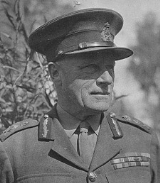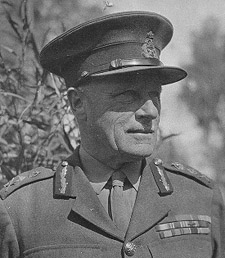
British Tenth Army
Encyclopedia

British Army during World War II
The British Army during the Second World War was, in 1939, a volunteer army, that introduced limited conscription in early 1939, and full conscription shortly after the declaration of war with Germany. During the early years of the war, the army suffered defeat in almost every theatre in which it...
created in Iraq
Iraq
Iraq ; officially the Republic of Iraq is a country in Western Asia spanning most of the northwestern end of the Zagros mountain range, the eastern part of the Syrian Desert and the northern part of the Arabian Desert....
and formed from the major part of "Paiforce" (Persia
Iran
Iran , officially the Islamic Republic of Iran , is a country in Southern and Western Asia. The name "Iran" has been in use natively since the Sassanian era and came into use internationally in 1935, before which the country was known to the Western world as Persia...
and Iraq Force). It was active in 1942 and 1943, and then disbanded.
In April 1941 British
United Kingdom
The United Kingdom of Great Britain and Northern IrelandIn the United Kingdom and Dependencies, other languages have been officially recognised as legitimate autochthonous languages under the European Charter for Regional or Minority Languages...
and Indian troops
British Indian Army
The British Indian Army, officially simply the Indian Army, was the principal army of the British Raj in India before the partition of India in 1947...
had been deployed to Iraq from India under the command of General Sir Edward Quinan
Edward Quinan
General Sir Edward Pellew Quinan KCB, KCIE, DSO, OBE was a British army commander during the Second World War. In the early part of his career, he was involved in Indian Army campaigns in Afghanistan and Waziristan on the North West Frontier of the Indian Empire, also known as the British Raj...
to protect British interests, in particular oil concessions, after a coup d'etat
Coup d'état
A coup d'état state, literally: strike/blow of state)—also known as a coup, putsch, and overthrow—is the sudden, extrajudicial deposition of a government, usually by a small group of the existing state establishment—typically the military—to replace the deposed government with another body; either...
had brought to power a government sympathetic to the Axis powers. The force was known as Iraqforce
Iraqforce
Iraqforce was a British and Commonwealth formation that came together in the Kingdom of Iraq. The formation fought in the Middle East during World War II.-Background:...
and was engaged in the Anglo-Iraqi War
Anglo-Iraqi War
The Anglo-Iraqi War was the name of the British campaign against the rebel government of Rashid Ali in the Kingdom of Iraq during the Second World War. The war lasted from 2 May to 31 May 1941. The campaign resulted in the re-occupation of Iraq by British armed forces and the return to power of the...
which took place in April and May Iraqi rebellion and took part in the defeat of the Vichy
Vichy
Vichy is a commune in the department of Allier in Auvergne in central France. It belongs to the historic province of Bourbonnais.It is known as a spa and resort town and was the de facto capital of Vichy France during the World War II Nazi German occupation from 1940 to 1944.The town's inhabitants...
forces in the subsequent Syria-Lebanon campaign
Syria-Lebanon campaign
The Syria–Lebanon campaign, also known as Operation Exporter, was the Allied invasion of Vichy French-controlled Syria and Lebanon, in June–July 1941, during World War II. Time Magazine referred to the fighting as a "mixed show" while it was taking place and the campaign remains little known, even...
. Later in 1941, the force took part in the Anglo-Soviet invasion of Iran
Anglo-Soviet invasion of Iran
The Anglo-Soviet invasion of Iran was the Allied invasion of the Imperial State of Iran during World War II, by British, Commonwealth, and Soviet armed forces. The invasion from August 25 to September 17, 1941, was codenamed Operation Countenance...
to prevent the Axis elements
Axis Powers
The Axis powers , also known as the Axis alliance, Axis nations, Axis countries, or just the Axis, was an alignment of great powers during the mid-20th century that fought World War II against the Allies. It began in 1936 with treaties of friendship between Germany and Italy and between Germany and...
from entering Persia, and preventing the possibility of the Germans
Germany
Germany , officially the Federal Republic of Germany , is a federal parliamentary republic in Europe. The country consists of 16 states while the capital and largest city is Berlin. Germany covers an area of 357,021 km2 and has a largely temperate seasonal climate...
gaining control of the Iraq
Iraq
Iraq ; officially the Republic of Iraq is a country in Western Asia spanning most of the northwestern end of the Zagros mountain range, the eastern part of the Syrian Desert and the northern part of the Arabian Desert....
i and Persian
Iran
Iran , officially the Islamic Republic of Iran , is a country in Southern and Western Asia. The name "Iran" has been in use natively since the Sassanian era and came into use internationally in 1935, before which the country was known to the Western world as Persia...
oil field
Oil field
An oil field is a region with an abundance of oil wells extracting petroleum from below ground. Because the oil reservoirs typically extend over a large area, possibly several hundred kilometres across, full exploitation entails multiple wells scattered across the area...
s. Following this Iraqforce was renamed Paiforce (Persia and Iraq force).
After the campaigns of 1941, Quinan's headquarters was redesignated Tenth Army and its main task was the maintenance of the lines of communication to the Soviet Union
Soviet Union
The Soviet Union , officially the Union of Soviet Socialist Republics , was a constitutionally socialist state that existed in Eurasia between 1922 and 1991....
from the Persian Gulf
Persian Gulf
The Persian Gulf, in Southwest Asia, is an extension of the Indian Ocean located between Iran and the Arabian Peninsula.The Persian Gulf was the focus of the 1980–1988 Iran-Iraq War, in which each side attacked the other's oil tankers...
to the Caspian
Caspian Sea
The Caspian Sea is the largest enclosed body of water on Earth by area, variously classed as the world's largest lake or a full-fledged sea. The sea has a surface area of and a volume of...
and the protection of the South Persian and Iraqi oilfields. Its badge was a golden Assyrian Lion with human head and eagle's wings (a Cherub Guardian). A variation of colouring of this badge was a white Lion on a pale blue background. Tenth Army was initially part of British Middle East Command but became part of Persia and Iraq Command when it was activated in September 1942.
Order of Battle 1942
- Tenth Army commanded by Lieutenant-General Sir Edward QuinanEdward QuinanGeneral Sir Edward Pellew Quinan KCB, KCIE, DSO, OBE was a British army commander during the Second World War. In the early part of his career, he was involved in Indian Army campaigns in Afghanistan and Waziristan on the North West Frontier of the Indian Empire, also known as the British Raj...
- British III Corps, Lieutenant-General Sir Desmond AndersonDesmond AndersonFor cricketer see Desmond Anderson Lieutenant-General Sir Desmond Francis Anderson, KBE, CB, CMG, DSO was a British officer in both World War I and World War II.-World War I:...
- 5th Infantry Division, Major-General Horatio Berney-FicklinHoratio Pettus Mackintosh Berney-FicklinMajor-General Horatio Pettus Mackintosh Berney-Ficklin CB MC was a British Army officer who served in World War I and World War II.-Military career:...
- 56th (London) Division, Major-General Eric MilesEric Grant MilesMajor-General Eric Grant Miles CB DSO MC served as an officer with the British Army during World War II.-Military career:Miles was commissioned into the King's Own Scottish Borderers in 1911...
- 5th Infantry Division, Major-General Horatio Berney-Ficklin
- Indian XXI CorpsIndian XXI CorpsThe Indian XXI Corps was an Army Corps of the Indian Army during World War II. It served in the Tenth Army in 1942.-Formation:Lieutenant-General Sir Mosley Mayne*8th Indian Infantry Division, Major-General Charles Harvey...
, Lieutenant-General Sir Mosley MayneMosley MayneGeneral Sir Ashton Gerard Oswald Mosley Mayne GCB, CBE, DSO was a British Indian Army officer in both World War I and World War II.-Early career:...
- Indian 8th Infantry DivisionIndian 8th Infantry DivisionThe 8th Indian Infantry Division is a division of the Indian Army which specialises in tactics and operations in mountainous territory.Originally formed in Meerut on 25 October 1940 under Major-General C.O...
, Major-General Charles HarveyCharles Offley HarveyMajor-General Sir Charles Harvey CB, CVO, CBE, MC was an officer in the British Indian Army during World War I and World War II.He was appointed CVO in 1922 for performing the duties of Assistant Military Secretary to the Prince of Wales during His.Royal Highness's Indian Tour and knighted in... - Indian 10th Infantry DivisionIndian 10th Infantry DivisionThe Indian 10th Infantry Division was a war formed Infantry division of the Indian Army during World War II. In four years, the division traveled over from Tehran to Trieste, fought three little wars, and fought two great campaigns: Anglo-Iraqi War, Invasion of Syria-Lebanon, Anglo-Soviet invasion...
, Major-General Alan BlaxlandAlan Bruce BlaxlandAlan Bruce Blaxland CB OBE was an officer in the British Indian Army during World War II.As part of Paiforce , Brigadier Blaxland commanded the 27th Indian Infantry Brigade of the Indian 6th Infantry Division during the Anglo-Soviet invasion of Persia.In 1942, Blaxland was made an acting...
- Indian 8th Infantry Division
- Indian 6th Infantry DivisionIndian 6th Infantry DivisionFor the World War I formation see 6th DivisionThe 6th Infantry Division was an infantry division of the Indian Army during World War II, created on 1 March 1941 in Secunderabad. On 11 September 1941 it was shipped to the Iraq and later Iran. During 1942 and 1943 it was part of the Tenth Army...
commanded by Major-General J.N. ThomsonJames Noel ThomsonJames Noel Thomson was an officer in the British Indian Army during World War II.As part of Iraqforce , Major-General Thomson commanded the Indian 6th Infantry Division during Anglo-Soviet invasion of Persia.-Command history:... - 31st Indian Armoured Division31st Indian Armoured DivisionThe 31st Indian Armoured Division was an armoured formation of the Indian Army during World War II, formed in 1940, as 1st Indian Armoured Division; it consisted of units of the British Army and the British Indian Army...
, Major-General Robert WordsworthRobert Harley WordsworthMajor-General Robert Harley Wordsworth was an officer in the British Indian Army during World War II.From 1942, major-general Wordsworth commanded the 31st Indian Armoured Division. As part of the British 10th Army, his division was stationed in Persia in 1942... - 10th Indian Motor Brigade10th Indian Motor BrigadeThe 10th Indian Motor Brigade was a formation of the Indian Army during World War II.It was formed in Egypt in March 1942. The brigade left Egypt for Persia in September 1942 and was converted to the 60th Indian Infantry Brigade in July 1943....
, Brigadier Harold RedmanHarold RedmanLieutenant General Sir Harold Redman, KCB, CBE was an officer in the British Indian Army during World War II and the post-war era.-Military career:...
- British III Corps, Lieutenant-General Sir Desmond Anderson

